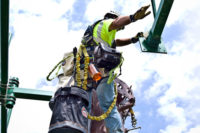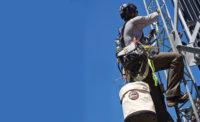Reality check
According to the Bureaus of Labor Statistics, in 2011, there were 219 fatalities from being struck by a falling object or equipment in the United States, which accounted for 5 percent of all workplace fatalities. Other negative results of dropped objects include the cost of damaged equipment — whether it is the dropped object itself or an object it impacts below. If a worker drops a $1,200 laser alignment device 60 meters onto the hood of a brand new company F-150… well, Houston, you’ve got an expensive and unnecessary problem on your hands.
Even if no damage or injury occurs, a worker can lose hours of productivity by retrieving a mission critical tool, wasting time and money for the company.
Objects at heights risks
| Objects at Heights safety involves the following key risks: |
|
1) Untethered, unorganized objects at an aerial jobsite. Pulling a wrench from the bottom of a pile; a jolt of a scissor lift that projects a bag of bolts; or an accidental kick of a loose tool off the ledge are what can happen. Pay special attention to cords, ropes and hoses that may line and/or cross walkways. Worker trips and falls can be caused by loose items and movement from scurrying around to locate them. |
|
2) Improper transport of objects to and from an aerial jobsite. When climbing, a worker must maintain three points of contact to the ladder or structure. Carrying a bag of tools up in one hand makes it difficult for a worker to abide by this important safety precaution. Not to mention, having to awkwardly carry equipment up to a location or overloading equipment onto a belt or harness. Buckets are a common solution; however, without a top, all it takes is one gust of wind to turn that bucket on its head — literally. |
Solutions for a DROPS FREE ZONE™
Regardless of shape or size; power or manual; bucket or bag; your gear needs to be where the job is at — whether that’s on our beloved terra firma or 90 flights closer to the spirit in the sky. The good news is there are numerous options to get your gear where it needs to be and keep it there safely.
First identify the specific challenges for the job at hand and formulate a plan. Next, identify solutions to help workers stay safe and be more productive. Critical solutions include:
1) Safely organize and tether all objects at an aerial jobsite.
Using organizers to keep cords, hoses and ropes tied up prevents them from becoming trip hazards. Efforts made to tie tools off on a lanyard or tethering device will pay for themselves in eliminating damage to equipment, reducing lost productivity, and most critically preventing injury or death.
2) Safely store and transport objects to and from an aerial jobsite.
Cover or close a container when in transit or when not accessing contents to prevent dropped objects. Your choice should always be a container or pouch with a cover or closure. If carrying a container, be sure it allows the worker to maintain three points of contact. If this proves difficult, look for a container with versatile handles or belt/body attachment methods to free hands to keep the worker on the structure. If the gear is too heavy to carry, the decision should be to hoist the equipment. Look for a weight rating on the product. A proper safety solution should have a stated weight rating and a safety factor built into the product for added confidence.
Mission critical
Think inside the bucket — and keep it organized up there!
Once workers are safely tied off, the next step is to ensure the equipment going up alongside them is just as secure. Identifying and preparing solutions for these challenges is mission critical to completing a full circle safety at heights plan.


